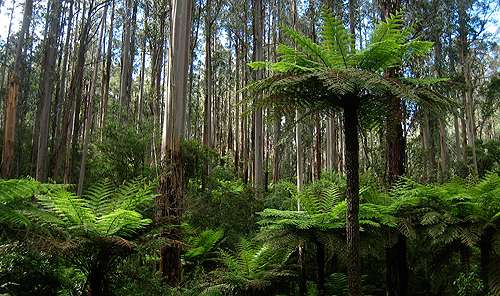Key to survival of forest giants revealed

(Phys.org)—Anyone flying into Melbourne from the east notices the thousands of hectares of dead Mountain Ash trees that were killed in the 2009 Black Saturday fires, which marked the culmination of an extended heatwave.
Why the Mountain Ash (Eucalyptus regnans) trees in the area that survived the blaze did not die, as expected, from the heatwave is explained by research by the University of Sydney and University of Western Sydney.
In addition to obvious threats to trees from fire, scientists worldwide are concerned about trees and whole forests dying during increasingly frequent drought and heatwaves, like that of 2009.
Tall trees are believed to be especially susceptible owing to the physical difficulties associated with getting water from the soil up to the leaves.
"There is a high probability that Mountain Ash forests, and the Melbourne water catchments they dominate, will face more droughts and higher temperatures in the future," said researcher Professor Mark Adams, Dean of the Faculty of Agriculture and Environment at the University.
"This research is a key step in predicting how they will respond and their capacity to support the ecosystem through services such as carbon sequestration and water yield."
Black Saturday marked the culmination of an extended heatwave and on that day, 21 of 33 long-term Victorian weather stations broke all-time temperature records, including Melbourne's 154-year record for maximum air temperatures.
Professor Adams and Dr Sebastian Pfautsch, from the University of Western Sydney, recorded the effects of the 2009 heatwave from within Mountain Ash forest at Britannia Creek, near Warburton. Their research was published this month in the journal Oecologia.
The trees' ability to survive is mainly due to their ability to store, use and refill water in their stems, especially, the researchers discovered, at night. Until recently, it had been widely assumed that water uptake at night was a minor process, but the Mountain Ash trees took up water during the night at rates up to 30 percent of daytime levels.
"The wood in the tree acts like a sponge which is emptied during the day and refilled with water at night," said Dr Pfautsch.
"The remarkable ability of this species to grow quickly and reach tremendous heights, yet survive extreme droughts and heatwaves, reinforces the need for research into one of Australia's great natural icons," said Dr Pfautsch.
"Long-term research is essential, and forest research, in particular, requires long-term funding and other support," said Professor Adams.
"Water use by Mountain Ash is critical to determining water yield for the City of Melbourne. Understanding how and how much the trees use water under extreme conditions, and understanding how extreme conditions affect the trees, is therefore vital to future catchment management."
"This research, coupled with our earlier studies of the structure of the water-conducting pathway of the trees, is showing us how tall trees evolve to cope with changing climates," Professor Adams said.
Journal information: Oecologia
Provided by University of Sydney




















